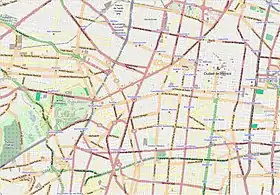Monumento a la Revolución
The Monument to the Revolution (Spanish: Monumento a la Revolución) is a memorial arch commemorating the Mexican Revolution. It is located in the Plaza de la República, near the heart of the major thoroughfares Paseo de la Reforma and Avenida de los Insurgentes in downtown Mexico City. The monument is considered the tallest memorial arch in the world, standing 67 metres (220 ft) in height.[1]
| Monument to the Revolution | |
|---|---|
| Native name Spanish: Monumento a la Revolución | |
 West facade and museum entrance | |
| Type | Monument |
| Location | Cuauhtémoc borough, Mexico City, Mexico |
| Built | 1910–1938 |
| Architect | |
 Location of Monument to the Revolution in Mexico City Central | |
History


.jpg.webp)

Legislative building
The building was initially planned as the Palacio Legislativo Federal (Federal Legislative Palace) during the regime of president Porfirio Díaz and "was intended as the unequaled monument to Porfirian glory."[2] The building would hold the congressional chambers of the deputies and senators, but the project was not finished due to the Mexican Revolution.
Porfirio Díaz appointed a French architect, Émile Bénard to design and construct the structure, a neoclassical design with "characteristic touches of the French renaissance,"[3] showing government officials' aim to demonstrate Mexico's rightful place as an advanced nation. Díaz laid the first stone in 1910 during the centennial celebrations of Independence, when Díaz also inaugurated the Monument to Mexican Independence ("The Angel of Independence").[2] The internal structure was made of iron, and rather than using local Mexican materials in the stone façade, the design called for Italian marble and Norwegian granite.[2] The Díaz regime was ousted in May 1911, but President Francisco I. Madero continued the project until his murder in 1913.[2] After Madero's death, the project was cancelled and abandoned.
Monument
The structure remained unfinished for twenty-five years, until the presidency of Lázaro Cárdenas,[4] when Mexican architect Carlos Obregón Santacilia proposed converting the abandoned shell of the dome into a monument to the heroes of the Mexican Revolution. After this was approved, the structure began its eclectic Art Deco and Mexican socialist realism conversion, building over the existing cupola structure.[5][6] Mexican sculptor Oliverio Martínez designed four stone sculpture groups for the monument,[7] with Francisco Zúñiga as one of his assistants. Work was completed in 1938.
_Monumento_a_la_Revoluci%C3%B3n.png.webp)
The structure also functions as a mausoleum for the heroes of the Mexican Revolution of 1910, Francisco I. Madero, Francisco "Pancho" Villa, Venustiano Carranza, Plutarco Elías Calles, and Lázaro Cárdenas. Revolutionary general Emiliano Zapata is not buried in the monument, but rather in Cuautla, Morelos. The Zapata family has resisted the Mexican government's efforts to relocate Zapata's remains to the monument.[8]
References
- "Monumento a la Revolucion". SkyscraperPage. Retrieved 26 November 2020.
- Benjamin, Thomas (January 1, 2010). La Revolución: Mexico's Great Revolution as Memory, Myth, and History. Austin: University of Texas Press. pp. 121–123. ISBN 9780292782976.
- Benjamin, La Revolución, p. 121.
- Vuelta, Jacobo Dale Vuelta (12 September 1937). "Está concluido el Monumento a la Revolución," El Universal. Mexico City.
- Obregón Santacilio, Carlos. El Monumento a la Revolución: Simbolismo e historia. Mexico: Secretaría de Educación Pública 1960.
- Garay Arrelleno, Graciela de. La obra de Carlos Obregón Santacilia, Arquitecto. Mexico: SEP/INBA 1979.
- Benjamin, La Revolución, p. 89, Figure 8 with caption.
- O'Malley, Ilene V. (1986). The Myth of the Mexican Revolution: Hero Cults and the Institutionalization of the Mexican State, 1920–1940. New York: Greenwood Press. pp. 69–70. ISBN 978-0313251849.
External links
- Official website
 Media related to Monumento a la Revolución (México) at Wikimedia Commons
Media related to Monumento a la Revolución (México) at Wikimedia Commons